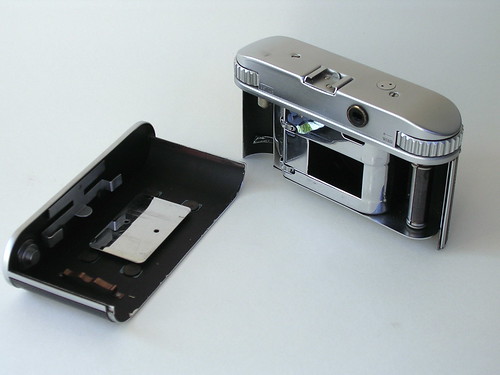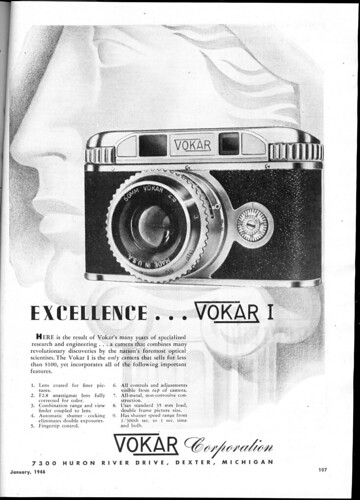Difference between revisions of "Vokar I"
(start stub with pool photos) |
m (wiki link back to company page) |
||
| Line 12: | Line 12: | ||
The '''Vokar I''' camera had been designed by Richard Bills before WWII<ref>''Glass, brass, & chrome: the American 35mm miniature camera'' Kalton C. Lahue and Joseph A. Bailey; University of Oklahoma Press, 2001. pgs. 284-285</ref>; but during wartime the Electonic Prodcucts Manufacturing Co. had diverted its resources into making bomb-fuse components<ref>[http://www.flickr.com/photos/camerawiki/5506497426/in/pool-camerawiki "Trade Notes and News"] ''Popular Photography'' (US magazine), January 1946, pg. 64.</ref>, delaying the camera's manufacture. | The '''Vokar I''' camera had been designed by Richard Bills before WWII<ref>''Glass, brass, & chrome: the American 35mm miniature camera'' Kalton C. Lahue and Joseph A. Bailey; University of Oklahoma Press, 2001. pgs. 284-285</ref>; but during wartime the Electonic Prodcucts Manufacturing Co. had diverted its resources into making bomb-fuse components<ref>[http://www.flickr.com/photos/camerawiki/5506497426/in/pool-camerawiki "Trade Notes and News"] ''Popular Photography'' (US magazine), January 1946, pg. 64.</ref>, delaying the camera's manufacture. | ||
| − | In late 1945 the company renamed itself "Vokar" (after its existing line of photo products)<ref>[http://www.flickr.com/photos/camerawiki/5502511089/in/pool-camerawiki "Available Now: The New Vokar Streamlined Projector"] (advertisement) ''Popular Photography'' (US magazine), December 1945, pg. 137.</ref>. The Vokar I camera was first advertised in January, 1946 photography magazines<ref>[http://www.flickr.com/photos/camerawiki/5505902559/in/pool-camerawiki "Excellence… Vokar I"] (advertisement) ''Popular Photography'' (US magazine), January 1946, pg. 107.</ref>. | + | In late 1945 the company renamed itself "[[Vokar]]" (after its existing line of photo products)<ref>[http://www.flickr.com/photos/camerawiki/5502511089/in/pool-camerawiki "Available Now: The New Vokar Streamlined Projector"] (advertisement) ''Popular Photography'' (US magazine), December 1945, pg. 137.</ref>. The Vokar I camera was first advertised in January, 1946 photography magazines<ref>[http://www.flickr.com/photos/camerawiki/5505902559/in/pool-camerawiki "Excellence… Vokar I"] (advertisement) ''Popular Photography'' (US magazine), January 1946, pg. 107.</ref>. |
| − | The camera's sleek styling owed nothing to the boxy [[Argus C3]], and for the era its specification was quite ambitious. It offered single-eyepiece framing and [[rangefinder]] focus; shutter cocking coupled to the film advance; an f/2.8 lens (at a time when f/3.5 or f/4.5 were standard) and a full range of shutter speeds from 1 to 1/300 sec. | + | The camera's sleek styling owed nothing to the boxy [[Argus C3]], and for the era its specification was quite ambitious. It offered single-eyepiece framing and [[rangefinder]] focus; shutter cocking coupled to the film advance; an f/2.8 lens (at a time when f/3.5 or f/4.5 were standard); and a full range of shutter speeds from 1 to 1/300 sec. |
However the small Vokar Corporation failed to make much of a dent in the US camera market, perhaps due to poor distribution. Sales were poor, and the camera disappeared rather quickly, making it a bit of a rarity today. | However the small Vokar Corporation failed to make much of a dent in the US camera market, perhaps due to poor distribution. Sales were poor, and the camera disappeared rather quickly, making it a bit of a rarity today. | ||
Revision as of 16:01, 7 March 2011

|
| Vokar I image by Rick Oleson (Image rights) |
The Vokar I camera had been designed by Richard Bills before WWII[1]; but during wartime the Electonic Prodcucts Manufacturing Co. had diverted its resources into making bomb-fuse components[2], delaying the camera's manufacture.
In late 1945 the company renamed itself "Vokar" (after its existing line of photo products)[3]. The Vokar I camera was first advertised in January, 1946 photography magazines[4].
The camera's sleek styling owed nothing to the boxy Argus C3, and for the era its specification was quite ambitious. It offered single-eyepiece framing and rangefinder focus; shutter cocking coupled to the film advance; an f/2.8 lens (at a time when f/3.5 or f/4.5 were standard); and a full range of shutter speeds from 1 to 1/300 sec.
However the small Vokar Corporation failed to make much of a dent in the US camera market, perhaps due to poor distribution. Sales were poor, and the camera disappeared rather quickly, making it a bit of a rarity today.
Notes
- ↑ Glass, brass, & chrome: the American 35mm miniature camera Kalton C. Lahue and Joseph A. Bailey; University of Oklahoma Press, 2001. pgs. 284-285
- ↑ "Trade Notes and News" Popular Photography (US magazine), January 1946, pg. 64.
- ↑ "Available Now: The New Vokar Streamlined Projector" (advertisement) Popular Photography (US magazine), December 1945, pg. 137.
- ↑ "Excellence… Vokar I" (advertisement) Popular Photography (US magazine), January 1946, pg. 107.

|
| Back of Vokar I; showing oddly chromed internal parts image by Rick Oleson (Image rights) |

|
| Earliest advertisement, January 1946 image by scan courtesy Voxphoto (Image rights) |